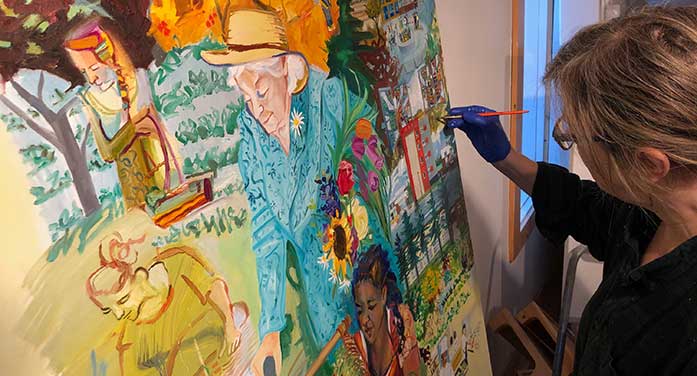
Artist and U of A master’s student Jill Thomson works on the painting that was turned into a massive mural for the Canterbury Heights seniors’ residence in west Edmonton. (Photo: Supplied)
Growing up in the rural midwest, Jill Thomson had a soft spot for bountiful farm gardens. It was an affection that blossomed as she moved to city life and began planting – and painting – her own urban patches of heaven.
 Jill Thomson |
 Wendy King |
Now, the longtime artist and University of Alberta Master of arts student is sharing her love of gardens through a colourful mural recently unveiled on the outside wall of a new wing for a seniors’ residence in west Edmonton.
Powered by arts-based human ecology research at the U of A, the tall mural painted by Thomson and installed on the side of Canterbury Heights in the city’s Laurier Heights neighbourhood celebrates the people living in the residence and in the community.
“We wanted to show the connection between Canterbury and the community, and the theme of an urban garden fits beautifully,” says Thomson, whose work is contributing to her degree in the Faculty of Agricultural, Life & Environmental Sciences.
Peppered with Laurier Heights landmarks, the mural features seniors working in the garden alongside children, reflecting an intergenerational bond developed over the years in the community.
“Students at the school across the street have come to help the seniors planting their gardens at Canterbury in the past, and I wanted to convey this connection,” Thomson says.
The idea for the vibrant, towering painting was born through art workshops Thomson and other ALES researchers delivered to seniors at the residence.
| RELATED CONTENT |
| Quebec artist bears witness to Africa’s climate migrants By Doug Firby |
| Letting your creative spirit loose By Mike Robinson |
| Banksy, and art’s uneasy alliance with capitalism By Michael Taube |
The sessions were originally meant to gather input through interviews and drawings from residents as research for an illustrated film being created as the latest in an awareness series focused on seniors. The newest film, a separate project created by U of A professor Megan Strickfaden and her team of researchers, will feature two seniors striking up a friendship in a garden.
In the workshops, Canterbury residents were encouraged to sketch garden-themed line drawings of fruit, vegetables and birds, and scribble down their thoughts – someone even shared a rhubarb muffin recipe.
As the work for the film unfolded, so did the potential theme for the mural, which the Canterbury Foundation had already planned on commissioning.
“We thought, wouldn’t it be wonderful if the residents’ work also informed the mural,” says Thomson, who is studying material culture.
“We knew that the residents, their families and community members needed to be part of the project, so this was the perfect solution to bring in the residents and their art into the development of the mural,” says Wendy King, CEO of the Canterbury Foundation.
“They did beautiful drawings, and the fact that they have a part in how the whole painting developed makes the piece really rich,” adds Thomson, who was independently contracted by the foundation to paint the mural.
Reproduced from a painting she created and then worked on at the residence and which now hangs there permanently, Thomson made sure the mural also reflected community input by meeting with the city councillor and the local community league for the area.
A survey of area residents resulted in images of neighbourhood landmarks like the Edmonton Valley Zoo, a dog park and the nearby school being included in the mural. Depictions of the Canterbury courtyard, dining room and chef preparing food from the residence garden were also added.

The colourful mural on the wall of the Canterbury Heights seniors’ residence makes a distinctive new landmark in the Laurier Heights neighbourhood. (Photo: Supplied)
The residence is situated in Ward sipiwiyiniwak, which references the people of the Enoch Cree Nation being River Cree, so Thomson also painted a river flowing through the work, acknowledging the traditional territory. “I wanted to put that land acknowledgement inside the painting itself, reflecting the entire community.”
Written reflections and drawings by Canterbury residents, their family members, staff, volunteers and even the researchers make up a banner at the base of the mural. “It adds another element of story to the whole piece,” Thomson says.
The mural is a point of pride for residents, says King.
“Their work becomes part of the mural, which creates a sense of ownership, pride and accomplishment for them. When they take walks around the building, they’ll be able to stop and look at the mural and talk to their friends and passersby about what it means.”
It also gives the neighbourhood a sense of ownership, she adds: “The places pictured in the mural are important to the community.”
Thomson felt privileged to create the community artwork, particularly for Canterbury residents.
“One of the residents said I had a gift I was sharing with them. I love that my visual language allows for something like this, to tell these stories in a painting.”
| By Bev Betkowski
Bev is a reporter with the University of Alberta’s Folio online magazine. The University of Alberta is a Troy Media Editorial Content Provider Partner.
The opinions expressed by our columnists and contributors are theirs alone and do not inherently or expressly reflect the views of our publication.
© Troy Media
Troy Media is an editorial content provider to media outlets and its own hosted community news outlets across Canada.

